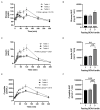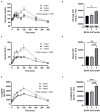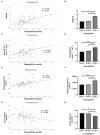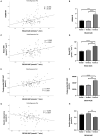Plasma Branched-Chain Amino Acids Are Associated With Greater Fasting and Postprandial Insulin Secretion in Non-diabetic Chinese Adults
- PMID: 33996878
- PMCID: PMC8113402
- DOI: 10.3389/fnut.2021.664939
Plasma Branched-Chain Amino Acids Are Associated With Greater Fasting and Postprandial Insulin Secretion in Non-diabetic Chinese Adults
Abstract
Background: Plasma branched-chain amino acids (BCAA) are consistently elevated in subjects with obesity and type 2 diabetes (T2DM) and correlate with insulin resistance. The association of BCAA with insulin secretion and clearance rates has not been adequately described. Objective: To evaluate the relationships between fasting and postprandial plasma BCAA, insulin secretion and insulin clearance. Design: Ninety-five non-diabetic Chinese subjects (43 females) underwent a mixed-meal tolerance test; blood biomarkers including BCAAs (leucine, isoleucine, valine) were measured for 6 h. Fasting and postprandial insulin secretion rates (ISR) and insulin clearance were determined by oral minimal modeling of glucose and C-peptide. Results: Fasting and postprandial plasma BCAA correlated strongly with each other (ρ = 0.796, P < 0.001), and both were positively associated with basal ISR (ρ = 0.45/0.36, P < 0.001), total postprandial ISR AUC (ρ = 0.37/0.45, P < 0.001), and negatively with insulin clearance (ρ = -0.29/-0.29, P < 0.01), after adjusting for sex and body mass index. These relationships largely persisted after adjusting further for insulin resistance and postprandial glucose. Compared with subjects in the middle and lowest tertiles for fasting or postprandial plasma BCAA, subjects in the highest tertile had significantly greater postprandial glucose (by 7-10%) and insulin (by 74-98%) concentrations, basal ISRs (by 34-53%), postprandial ISR AUCs (by 41-49%), and lower insulin clearance rates (by 17-22%) (all P < 0.05). Conclusions: Fasting and postprandial plasma BCAA levels are associated with greater fasting and postprandial insulin secretion and reduced insulin clearance in healthy Chinese subjects. These observations potentially highlight an additional layer of involvement of BCAA in the regulation of glucose homeostasis.
Keywords: BCAA; glucose homeostasis; insulin clearance; insulin metabolism; insulin resistance.
Copyright © 2021 Ding, Egli, Bosco, Sun, Goh, Yeo, Yap, Actis-Goretta, Leow and Magkos.
Conflict of interest statement
CD, NB, LE, and LA-G are (or have been, at the time of the study) employees of Nestlé Research, Singapore. The remaining authors declare that the research was conducted in the absence of any commercial or financial relationships that could be construed as a potential conflict of interest.
Figures





Similar articles
-
Diabetes and branched-chain amino acids: What is the link?J Diabetes. 2018 May;10(5):350-352. doi: 10.1111/1753-0407.12645. Epub 2018 Feb 13. J Diabetes. 2018. PMID: 29369529
-
Plasma Branched-Chain Amino Acid Concentrations and Glucose Homeostasis in Kidney Transplant Recipients and Candidates.Can J Kidney Health Dis. 2023 Apr 18;10:20543581231168085. doi: 10.1177/20543581231168085. eCollection 2023. Can J Kidney Health Dis. 2023. PMID: 37101847 Free PMC article.
-
Branched-Chain Amino Acids Associate Negatively With Postprandial Insulin Secretion in Recent-Onset Diabetes.J Endocr Soc. 2021 Apr 20;5(6):bvab067. doi: 10.1210/jendso/bvab067. eCollection 2021 Jun 1. J Endocr Soc. 2021. PMID: 34027277 Free PMC article.
-
Branched-Chain Amino Acids and Insulin Resistance, from Protein Supply to Diet-Induced Obesity.Nutrients. 2022 Dec 23;15(1):68. doi: 10.3390/nu15010068. Nutrients. 2022. PMID: 36615726 Free PMC article. Review.
-
Insulin action, type 2 diabetes, and branched-chain amino acids: A two-way street.Mol Metab. 2021 Oct;52:101261. doi: 10.1016/j.molmet.2021.101261. Epub 2021 May 24. Mol Metab. 2021. PMID: 34044180 Free PMC article. Review.
Cited by
-
The mitochondrial BCKD complex interacts with hepatic apolipoprotein E in cultured cells in vitro and mouse livers in vivo.Cell Mol Life Sci. 2023 Feb 7;80(3):59. doi: 10.1007/s00018-023-04706-x. Cell Mol Life Sci. 2023. PMID: 36749362 Free PMC article.
-
Branched-chain amino acids supplementation induces insulin resistance and pro-inflammatory macrophage polarization via INFGR1/JAK1/STAT1 signal pathway.Mol Med. 2024 Sep 12;30(1):149. doi: 10.1186/s10020-024-00894-9. Mol Med. 2024. PMID: 39267003 Free PMC article.
-
Multi-country metabolic signature discovery for chicken health classification.Metabolomics. 2023 Feb 2;19(2):9. doi: 10.1007/s11306-023-01973-4. Metabolomics. 2023. PMID: 36732451 Free PMC article.
-
Interlinking the Cross Talk on Branched Chain Amino Acids, Water Soluble Vitamins and Adipokines in the Type 2 Diabetes Mellitus Etiology.Endocr Metab Immune Disord Drug Targets. 2025;25(10):757-766. doi: 10.2174/0118715303305579241014112730. Endocr Metab Immune Disord Drug Targets. 2025. PMID: 39791169 Free PMC article. Review.
-
Mathematical model of insulin kinetics accounting for the amino acids effect during a mixed meal tolerance test.Front Endocrinol (Lausanne). 2022 Sep 15;13:966305. doi: 10.3389/fendo.2022.966305. eCollection 2022. Front Endocrinol (Lausanne). 2022. PMID: 36187117 Free PMC article.
References
LinkOut - more resources
Full Text Sources
Other Literature Sources

